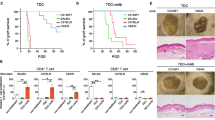Summary
53 LBNF1 kidneys were grafted into L-rats. 24 untreated recipients served as control and survived 16.1 ± 1.7 days. 14 recipients were treated with 4 ml alloantiserum (ADS) each, and the other 15 animals with 4 ml ALS each. 9 and 10 of these 14 and 15 animals survived for more than 4 months. We performed GvH-reaction with spleen cells of these 19 animals. It showed normal cellular immune response. After splenectomy first donor specific skin was transplanted, 18 days later second skin of same origin (LBNF1) and 18 days after third party skin (LBufF1). The first grafts survived 13.1 ± 1.9 days in the recipients of ADS treatment and 12.2 ± 1.2 days in the recipients of ALS. Second skin grafts were rejected delayed in the former recipients as the first grafts, in the later more accelerated than the first grafts. The third grafts survived as the controls. Before and after skin grafting we could not detect lymphocytotoxin and hemagglutinin. The sera of animals with ADS therapy inhibited the spontaneous allorosette formation to 46.0 ± 4.4% and of ALS therapy 37.7 ± 9.2%.
Our results suggest that after ALS treatment blocking antibodies were produced in the recipients and they cause the enhancement of kidney allograft.
Zusammenfassung
53 LBNF1-Nieren wurden auf L-Ratten transplantiert: 24 unbehandelte Empfänger überlebten durchschnittlich 16,1 ± 1,7 Tage. 14 Empfänger bekamen je 4 ml Alloantiserum (ADS, Gruppe 2), die restlichen 15 je 4 ml ALS (Gruppe 3). Davon überlebten 9 bzw. 10 Empfänger mehr als 4 Monate. Mit Milzzellen dieser permanent überlebenden 19 Ratten wurde eine GvHR durchgeführt. Grad und Index der GvHR ergaben eine normale, zellgebundene Immunantwort der Empfänger. Nach der Splenektomie erhielten sie erstmalig, 18 Tage später zum zweiten Mal Haut von LBNF1, 18 Tage danach Haut von LBufF1 transplantiert. Das erste Transplantat überlebte in der ADS-Gruppe 13,1 ± 1,9 Tage, in der ALS-Gruppe 12,2 ± 1,2 Tage. Das zweite wurde bei Gruppe 2 ebenfalls verzögert, bei Gruppe 3 fast gleich wie bei unbehandelten L-Ratten, das unspezifische Transplantat in beiden Gruppen regelrecht abgestoßen. Lymphozytotoxin und Hämagglutinin wurden vor und nach der Hauttransplantation bis zum 53. Tag nicht nachgewiesen. Die Seren beider Gruppen inhibierten die Allorosettenformation auf 46,0 ± 4,4% (ADS-Gruppen) bzw. 37,7 ± 9,2% (ALS-Gruppe), somit war ein blockierender FAktor im Serum der Empfänger vorhanden. Höchstwahrscheinlich hatten sich also bei diesen Empfängern nach der ALS-Therapie blockierende Antikörper gebildet, woraus sich ein Enhancement der Nierentransplantate entwickelte.
Similar content being viewed by others
Literatur
BACH, J.F., DARDENNE, M.: Thymus dependency of rosette-forming cells: evidence for a circulating thymic hormone. Transpl. Proc.4 345 (1972)
BIESECKER, J.L., FITCH, F.W., ROWLEY, D.A., STUART, F.P: Cellular and humoral immunity after allogeneic transplantation in the rat. IV. The effect of heterologous antilymphocyte serum on cellular and humoral immunity after allogeneic renal transplantation. Transplantation16 441 (1973)
BIESECKER, J.L., FITCH, F.W., ROWLEY, D.A., STUART, F.P.: Cellular and humoral immunity after allogeneic transplantation in the rat. III. The effect of passive antibody on cellular and humoral immunity after allogeneic renal transplantation. Transplantation16 432 (1973)
BILLINGHAM, R.E., SILVERS, W.K.: Transplantation of tissue and cells. Philadelphia: Wister 1961
BÖHRINGER/Mannheim: Biochemical test combination for creatinin
ELKINS, W.L.: Invasion and destruction of homologous kidney by locally inoculated lymphoid cells. J. exp. Med.120 329 (1964)
FRENCH, M.E., BATCHELOR, J.R., WATTS, H.G.: The capacity of lymphocytes from rats bearing enhanced kidney allografts to mount graft-versus-host reactions. Transplatation12 45 (1971)
GLUCKMAN, J.C., BANSAL, S.C., WRIGHT, P.W., HELLSTRÖM, K.E.: Inhibition of spontaneous allorosette formation by sera from tolerant rats. Transplantation17 97 (1974)
GUTTMANN, R.D., LINDQUIST, R.R., OEKNER, S.A.: Renal transplantation in the inbred rat. XII. A mechaniksm of long-term survival of allografts after antithymocyte immunoglobulin treatment. Transplantation8 837 (1969)
GUTTMANN, R.D.: Renal transplantation in the inbred rat. XIX. In vitro correlates of enhancement induction. Transplantation15 594 (1973)
HAEFEN, U. von, WREN, S.F.G., SHAPIPANICH, T., MARTINS, A.C.P., BUSCH, G.J., WILSON, R.E.: Active enhancement of rat renal allografts with Papain-released specific antigens. Transplantation16 295 (1973)
LANCE, E.M.: The mechanism of action of anti-lymphocyte serum: studies of antibody eluate. J. exp. Med.130 49 (1969)
LANCE, E.M., BATCHELOR, J.R.: Selective suppression of cellular immunity by anti-lymphocyte serum. Transplantation6 490 (1968)
LEE, S.: An improved technique of renal transplantation in the rat. Surgery61 771 (1967)
LEVEY, R.H., MEDAWAR, R.B.: Some experiments on the action of antilymphocytic antiserum. Ann. N.Y. Acad. Sci.129 164 (1966)
LIE, T.S., EBATA, H., KIM, W.I., GRÜNN, U.: Active enhancement of rat kidney allografts - Effect of pretreatment with prednisolone and donorspecific antigen. Transplantation (im Druck)
PICHLMAYR, R., BRENDEL, W., ZENKER, R.: Production and effect of heterologous anti-canine lymphocyte serum. Surgery61 774 (1967)
STIMPFLING, J.H.: The use of PVP as a developing agent in mouse hemagglutination test. Transpl. Bull.27 109 (1961)
STUART, F.P., FITCH, F.W., ROWLEY, D.A., BIESECKER, J.L., HELLSTRÖM, K.E., HELLSTRÖM, I.: Presence of both cell-mediated immunity and serum-blocking factors in rat renal allografts "enhanced" by passive immunization. Transplantation12 331 (1971)
STUART, F.P., FITCH, F.W., ROWLEY, D.A.: Specific suppression of renal allograft rejection by treatment with antigen and antibody. Transpl. Proc.2 483, 1970
Author information
Authors and Affiliations
Rights and permissions
About this article
Cite this article
Lie, T.S., Kanda, M., Kim, W.I. et al. Immunologischer Status permanent überlebender Rattennierenallotransplantant-Empfänger nach kurzer initialer ALS-Therapie. Res. Exp. Med. 167, 171–183 (1976). https://doi.org/10.1007/BF01851598
Received:
Issue Date:
DOI: https://doi.org/10.1007/BF01851598




